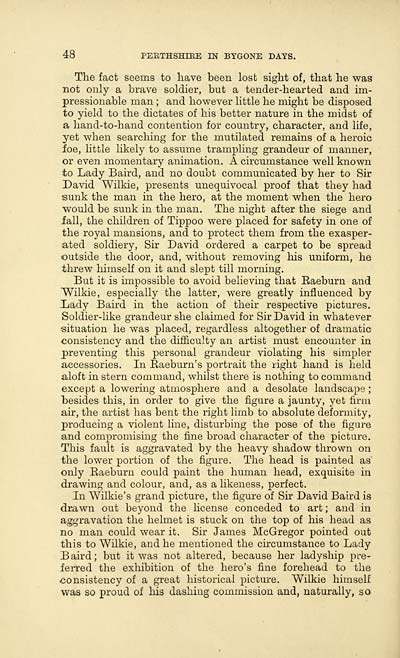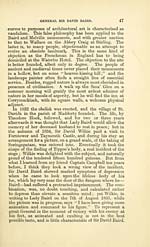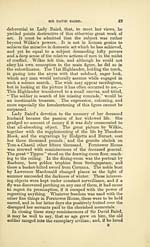Perthshire in bygone days
(76) Page 48
Download files
Complete book:
Individual page:
Thumbnail gallery: Grid view | List view

48 PEETHSHIBE IN BYGONE DATS.
The fact seems to have been lost sight of, that he was
not only a brave soldier, but a tender-hearted and im-
pressionable man ; and however little he might be disposed
to yield to the dictates of his better nature in the midst of
a hand-to-hand contention for country, character, and life,
yet when searching for the mutilated remains of a heroic
foe, little likely to assume trampling grandeur of manner,
or even momentary animation. A circumstance well known
to Lady Baird, and no doubt communicated by her to Sir
David Wilkie, presents unequivocal proof that they had
sunk the man in the hero, at the moment when the hero
would be sunk in the man. The night after the siege and
fall, the children of Tippoo were placed for safety in one of
the royal mansions, and to protect them from the exasper-
ated soldiery, Sir David ordered a carpet to be spread
outside the door, and, without removing his uniform, he
threw himself on it and slept till morning.
But it is impossible to avoid believing that Raeburn and
"Wilkie, especially the latter, were greatly influenced by
Lady Baird in the action of their respective pictures.
Soldier-like grandeur she claimed for Sir David in whatever
•situation he was placed, regardless altogether of dramatic
consistency and the difficulty an artist must encounter in
preventing this personal grandeur violating his simpler
accessories. In Baeburn's portrait the right hand is held
aloft in stern command, whilst there is nothing to command
except a lowering atmosphere and a desolate landscape ;
besides this, in order to give the figure a jaunty, yet firm
air, the artist has bent the right limb to absolute deformity,
producing a violent line, disturbing the pose of the figure
and compromising the fine broad character of the picture.
This fault is aggravated by the heavy shadow thrown on
the lower portion of the figure. The head is painted as
only Baeburn could paint the human head, exquisite in
drawing and colour, and, as a likeness, perfect.
In Wilkie's grand picture, the figure of Sir David Baird is
drawn out beyond the license conceded to art ; and in
aggravation the helmet is stuck on the top of his head as
no man could wear it. Sir James McGregor pointed out
this to Wilkie, and he mentioned the circumstance to Lady
Baird; but it was not altered, because her ladyship pre-
ferred the exhibition of the hero's fine forehead to the
-consistency of a great historical picture. Wilkie himself
was so proud of his dashing commission and, naturally, so
The fact seems to have been lost sight of, that he was
not only a brave soldier, but a tender-hearted and im-
pressionable man ; and however little he might be disposed
to yield to the dictates of his better nature in the midst of
a hand-to-hand contention for country, character, and life,
yet when searching for the mutilated remains of a heroic
foe, little likely to assume trampling grandeur of manner,
or even momentary animation. A circumstance well known
to Lady Baird, and no doubt communicated by her to Sir
David Wilkie, presents unequivocal proof that they had
sunk the man in the hero, at the moment when the hero
would be sunk in the man. The night after the siege and
fall, the children of Tippoo were placed for safety in one of
the royal mansions, and to protect them from the exasper-
ated soldiery, Sir David ordered a carpet to be spread
outside the door, and, without removing his uniform, he
threw himself on it and slept till morning.
But it is impossible to avoid believing that Raeburn and
"Wilkie, especially the latter, were greatly influenced by
Lady Baird in the action of their respective pictures.
Soldier-like grandeur she claimed for Sir David in whatever
•situation he was placed, regardless altogether of dramatic
consistency and the difficulty an artist must encounter in
preventing this personal grandeur violating his simpler
accessories. In Baeburn's portrait the right hand is held
aloft in stern command, whilst there is nothing to command
except a lowering atmosphere and a desolate landscape ;
besides this, in order to give the figure a jaunty, yet firm
air, the artist has bent the right limb to absolute deformity,
producing a violent line, disturbing the pose of the figure
and compromising the fine broad character of the picture.
This fault is aggravated by the heavy shadow thrown on
the lower portion of the figure. The head is painted as
only Baeburn could paint the human head, exquisite in
drawing and colour, and, as a likeness, perfect.
In Wilkie's grand picture, the figure of Sir David Baird is
drawn out beyond the license conceded to art ; and in
aggravation the helmet is stuck on the top of his head as
no man could wear it. Sir James McGregor pointed out
this to Wilkie, and he mentioned the circumstance to Lady
Baird; but it was not altered, because her ladyship pre-
ferred the exhibition of the hero's fine forehead to the
-consistency of a great historical picture. Wilkie himself
was so proud of his dashing commission and, naturally, so
Set display mode to:
![]() Universal Viewer |
Universal Viewer | ![]() Mirador |
Large image | Transcription
Mirador |
Large image | Transcription
Images and transcriptions on this page, including medium image downloads, may be used under the Creative Commons Attribution 4.0 International Licence unless otherwise stated. ![]()
| Histories of Scottish families > Perthshire in bygone days > (76) Page 48 |
|---|
| Permanent URL | https://digital.nls.uk/94907310 |
|---|
| Description | A selection of almost 400 printed items relating to the history of Scottish families, mostly dating from the 19th and early 20th centuries. Includes memoirs, genealogies and clan histories, with a few produced by emigrant families. The earliest family history goes back to AD 916. |
|---|

